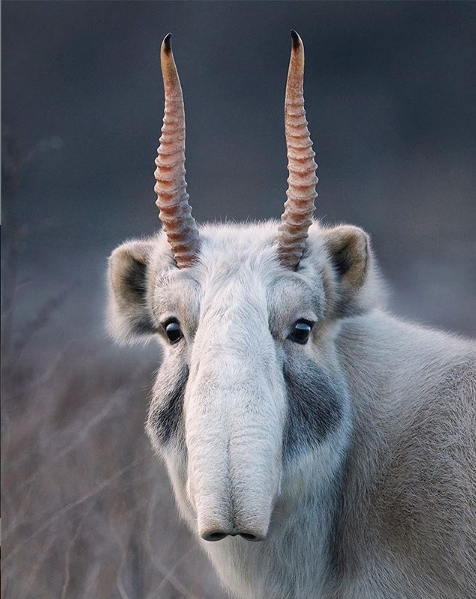SAIGA ANTELOPE
The saiga is a little types of impala, about the size of a goat (63-80cm shoulder stature and 23-40kg in weight), which has a stooping body, an enormous head, an unmistakable pendant proboscis nose, and an abnormal 'all over' style of running. Its jacket is a light buff shading, which gets thicker and white in the winter. Guys have pale yellowish horns, 28-38cm long.
HISTORY
Going back in any event to the extent the last ice age, saiga gazelles once went crosswise over nearly the entire of Asia and Europe. Reports from the nineteenth Century portray colossal groups covering the entire steppe. For a significant part of the twentieth century, great populaces were found in Kazakhstan, Russia, Uzbekistan, Mongolia, and now and again Turkmenistan. The species was chased, to a great extent for its horns, yet this was all around overseen. The high conceptive capability of the species (females arrive at sexual development at not exactly a year and for the most part bring forth twins) implied that populaces could endure a specific level of chasing.
Sadly for the saiga, the fall of the Soviet Union in the mid-1990s disastrously affected the country economies of the considerable number of nations in which it is found. Broad joblessness and destitution lead to expanded chasing for nourishment and exchange. The opening of outskirts for exchange with China just exacerbated this. China has a gigantic craving for saiga horn, for conventional medication.
Over the most recent 15 years, worldwide populaces of saiga pronghorn have fallen by 95%
Environment
This pronghorn might be found in crowds of up to 1000 people and lean towards desert-steppe zones with bushes and different herbaceous vegetation. It benefits from different grasses, onions, bushes, and other desert plants.
The populace in Mongolia is of the subspecies Saiga tatarica mongolicus, and numbers around 750 people (www.iucnredlist.org). They are found for the most part inside ensured zones in remote south-western Mongolia – Govi Altai and Hovd aimags (areas), and until 1960 were likewise found in China. They regularly relocate enormous separations consistently, looking for good field and wellsprings of water. In the fall, crowds move south to keep away from day off mate in December. Predominant guys mate with a guard gatherings of up to 30 females. The eland move north by and by in April. Youthful are conceived toward the beginning of June after an incubation of around 150 days.
SIGNS
Hair and little heaps of circular dark droppings might be found in the field.
Protection APPROACH
The Saiga Antelope was added to the IUCN's Red List as 'Fundamentally Endangered' in 2001. Albeit defensive enactment has existed in a significant number of these nations for quite a long while, endeavors are at present in progress to improve law authorization and bolster rustic economies. Secured Area systems are being reinforced, and a few global preservation associations are focused on supporting this species. Since 2006, the Saiga Conservation Alliance has been working with the Convention on Migratory Species.
Starting in 2010, the worldwide populace is believed to be around 50,000 people, generally in Kazakhstan. The Mongolian populace is found in two remote zones of western Mongolia, generally inside the Sharga Nature Reserve, and Mankhan Nature Reserve (both assigned in 1993).
Preservation associations are announcing positive effects from their work in certain territories, in any case, obviously more should be done, over the species' entire range.
Dangers
The fundamental danger to the endurance of the Saiga Antelope is chasing. The effect of this danger far surpasses that of normal predators, for example, wolves and foxes, fire, pulverization of territory, obstructing of relocation courses, brutal winters, or changing examples of agribusiness. As clarified over, the chasing of saiga quickly quickened during the 1990s, incompletely because of the rewarding exchange saiga horn for Chinese prescription. Today it can get up to $100 per kilogram (www.saiga-conservation.com).
Notwithstanding the undeniable consumption in numbers, the chasing of male saiga for their horns prompts exceptionally slanted populace structures. A circumstance quickly happened where there were insufficient guys to mate with every one of the females. This brought about 'regenerative breakdown', and obliteration of populaces.


